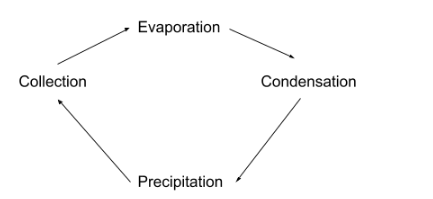Water is a liquid that is colourless, odourless, clear, and tasteless in nature. It is essential for plants and animal life. The maximum part of the Earth is covered with water (two-thirds). Most of the water is present in the oceans and is saline. Thus, it is unfit for drinking and other domestic, agricultural, and industrial needs. Some sources of usable water are ponds, lakes, rivers, and wells. Air is another important part of life on earth. The air is composed of nitrogen, oxygen and other elements. It is essential for the survival of plants in animals on land and underwater. Both air and water are essential for life.
Water Cycle

- The circulation of water from the Earth to the cloud and again from the cloud to the ocean is known as the water cycle.
- The water collected in water bodies gets converted into the gaseous state due to a process called evaporation. The resulting state is also called water vapour.
- Water also goes to the atmosphere through plants by the process of transpiration. In this, water turns into vapours in plants through pores known as stomata.
- Along with these processes, water from various sources, such as soil, or ice, also go through the process of evaporation.
- Once water in the atmosphere exceeds the capacity of the air, it begins to turn into the liquid state, a process known as condensation.
- When water gets converted into its liquid state, it comes back to the Earth in the form of precipitation. This may take the form of snow, rain, or even hailstorms.
- Precipitation then results in the replenishment of water in sources, thus leading to the collection of water.
- Rain, hail, and snow replenish water in rivers, lakes, ponds, wells, and soil.
Rainwater Harvesting
The technique of preserving rainwater by collection and storage is known as Rainwater Harvesting. Two techniques of rainwater harvesting are:
- Rooftop rainwater harvesting: The rainwater is collected from the rooftop and is stored in the tank through pipes.
- Surface runoff harvesting: Rainwater goes into the ground directly from the roadside drains that collect rainwater.
Today, we are facing a severe shortage of water and hence, it is important for us to use the water in a careful manner.
Air around Us:
Air is a mixture of Nitrogen, Oxygen, Carbon dioxide, water vapour, and a few other gases along with dust particles. Air is present everywhere in blank space, soil, and water. The natural movement of air is known as wind.
Components of Air:
- There are 4 main components of air, namely nitrogen, oxygen, carbon dioxide, and water vapour.
- A major part of air is Nitrogen, and it is one of the building blocks of life.
- For the survival of living organisms and burning, Oxygen is necessary.
- Carbon dioxide is the most important substance for photosynthesis.
- Water vapour and air are important for the water cycle in nature.
- Apart from these, air also includes argon, helium, methane, and hydrogen.
Role of Air:
- The mixture of air that surrounds the whole Earth is known as the atmosphere. Life on the Earth is possible because of the atmosphere.
- Air helps in the movements of sailing gliders, parachutes, and aeroplanes.
- Air propels the windmills, which are also used to generate electricity.
- Birds, bats, and insects fly with the help of air.
- Aquatic animals do respiration by using dissolved air in the water.
- Air is one of the mediums that help in the dispersal of seeds and pollen of flowers of several plants.
- Air and water vapour play an important role in the water cycle.
- Air helps in maintaining the temperature of the earth.
The process of respiration in plants and animals and the photosynthesis process in plants balance the oxygen and carbon dioxide in the atmosphere.
Availability of Oxygen to Animals and Plants
- Animals and plants that live in the soil receive oxygen through soil gas. This is through a process called diffusion, where oxygen gets mixed in the soil.
- In terrestrial habitats, oxygen is present in abundance in the air.
- In aquatic habitats, oxygen gets mixed with the surface water and is made available to aquatic life.
- Aquatic animals such as fish have such bodies that allow for the absorption of oxygen from water. They have structures called gills which take in water which contains oxygen.
- Dissolved oxygen is also useful to aquatic plants.
- Along with this, aquatic plants also produce oxygen through the process of photosynthesis that helps provide oxygen to aquatic life.
Conclusion
Water is an important aspect of the earth. It is essential for the survival of animals and plants. The water cycle is a process by which water is made available to all living organisms. In this process, water goes into the air and comes back to the earth as a result of rainfall. Rainwater can be preserved through processes such as rainwater harvesting. Air, too, is important for preserving life on earth. It is composed of nitrogen, oxygen, carbon dioxide, and other elements. There are different forms in which air is available, such as in the soil or dissolved in the water.
 Profile
Profile Settings
Settings Refer your friends
Refer your friends Sign out
Sign out












